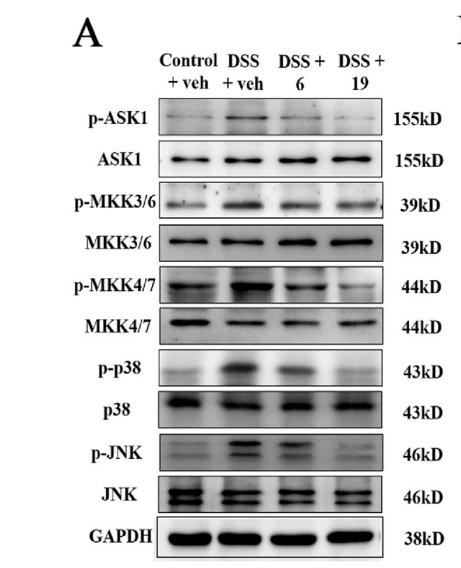MKK3 Antibody - #AF6327
| Product: | MKK3 Antibody |
| Catalog: | AF6327 |
| Description: | Rabbit polyclonal antibody to MKK3 |
| Application: | WB IHC IF/ICC |
| Cited expt.: | WB |
| Reactivity: | Human, Mouse, Rat |
| Prediction: | Pig, Bovine, Horse, Sheep, Rabbit, Dog, Chicken, Xenopus |
| Mol.Wt.: | 40kDa; 39kD(Calculated). |
| Uniprot: | P46734 |
| RRID: | AB_2835183 |
Product Info
*The optimal dilutions should be determined by the end user. For optimal experimental results, antibody reuse is not recommended.
*Tips:
WB: For western blot detection of denatured protein samples. IHC: For immunohistochemical detection of paraffin sections (IHC-p) or frozen sections (IHC-f) of tissue samples. IF/ICC: For immunofluorescence detection of cell samples. ELISA(peptide): For ELISA detection of antigenic peptide.
Cite Format: Affinity Biosciences Cat# AF6327, RRID:AB_2835183.
Fold/Unfold
AW212142; dual specificity mitogen activated protein kinase kinase 3; Dual specificity mitogen-activated protein kinase kinase 3; MAP kinase kinase 3; map2k3; MAPK ERK kinase 3; MAPK/ERK kinase 3; MAPKK 3; MAPKK3; MEK 3; MEK3; Mitogen activated protein kinase kinase 3; MKK 3; MKK3; mMKK3b; MP2K3_HUMAN; PRKMK 3; PRKMK3; protein kinase, mitogen-activated, kinase 3; SAPK kinase 2; SAPKK 2; SAPKK2; Stress activated protein kinase kinase 2;
Immunogens
A synthesized peptide derived from human MKK3, corresponding to a region within the internal amino acids.
Abundant expression is seen in the skeletal muscle. It is also widely expressed in other tissues.
- P46734 MP2K3_HUMAN:
- Protein BLAST With
- NCBI/
- ExPASy/
- Uniprot
MESPASSQPASMPQSKGKSKRKKDLRISCMSKPPAPNPTPPRNLDSRTFITIGDRNFEVEADDLVTISELGRGAYGVVEKVRHAQSGTIMAVKRIRATVNSQEQKRLLMDLDINMRTVDCFYTVTFYGALFREGDVWICMELMDTSLDKFYRKVLDKNMTIPEDILGEIAVSIVRALEHLHSKLSVIHRDVKPSNVLINKEGHVKMCDFGISGYLVDSVAKTMDAGCKPYMAPERINPELNQKGYNVKSDVWSLGITMIEMAILRFPYESWGTPFQQLKQVVEEPSPQLPADRFSPEFVDFTAQCLRKNPAERMSYLELMEHPFFTLHKTKKTDIAAFVKEILGEDS
Predictions
Score>80(red) has high confidence and is suggested to be used for WB detection. *The prediction model is mainly based on the alignment of immunogen sequences, the results are for reference only, not as the basis of quality assurance.
High(score>80) Medium(80>score>50) Low(score<50) No confidence
Research Backgrounds
Dual specificity kinase. Is activated by cytokines and environmental stress in vivo. Catalyzes the concomitant phosphorylation of a threonine and a tyrosine residue in the MAP kinase p38. Part of a signaling cascade that begins with the activation of the adrenergic receptor ADRA1B and leads to the activation of MAPK14.
Autophosphorylated. Phosphorylation on Ser-218 and Thr-222 by MAP kinase kinase kinases regulates positively the kinase activity. Phosphorylated by TAOK2.
Yersinia yopJ may acetylate Ser/Thr residues, preventing phosphorylation and activation, thus blocking the MAPK signaling pathway.
Abundant expression is seen in the skeletal muscle. It is also widely expressed in other tissues.
Belongs to the protein kinase superfamily. STE Ser/Thr protein kinase family. MAP kinase kinase subfamily.
Research Fields
· Cellular Processes > Cell growth and death > Cellular senescence. (View pathway)
· Environmental Information Processing > Signal transduction > MAPK signaling pathway. (View pathway)
· Environmental Information Processing > Signal transduction > Rap1 signaling pathway. (View pathway)
· Environmental Information Processing > Signal transduction > TNF signaling pathway. (View pathway)
· Human Diseases > Neurodegenerative diseases > Amyotrophic lateral sclerosis (ALS).
· Human Diseases > Infectious diseases: Parasitic > Toxoplasmosis.
· Human Diseases > Infectious diseases: Viral > Influenza A.
· Human Diseases > Infectious diseases: Viral > Epstein-Barr virus infection.
· Organismal Systems > Immune system > Toll-like receptor signaling pathway. (View pathway)
· Organismal Systems > Immune system > Fc epsilon RI signaling pathway. (View pathway)
· Organismal Systems > Sensory system > Inflammatory mediator regulation of TRP channels. (View pathway)
References
Application: WB Species: mice Sample: colon tissues
Application: WB Species: chicken Sample: jejunal mucosa
Application: WB Species: Human Sample:
Restrictive clause
Affinity Biosciences tests all products strictly. Citations are provided as a resource for additional applications that have not been validated by Affinity Biosciences. Please choose the appropriate format for each application and consult Materials and Methods sections for additional details about the use of any product in these publications.
For Research Use Only.
Not for use in diagnostic or therapeutic procedures. Not for resale. Not for distribution without written consent. Affinity Biosciences will not be held responsible for patent infringement or other violations that may occur with the use of our products. Affinity Biosciences, Affinity Biosciences Logo and all other trademarks are the property of Affinity Biosciences LTD.




